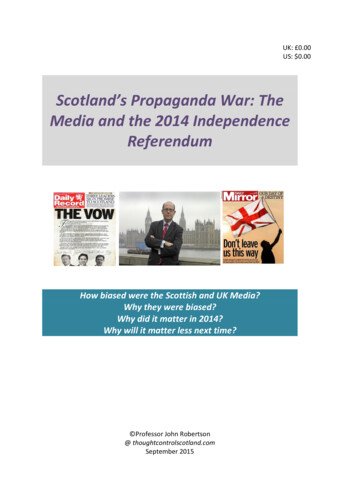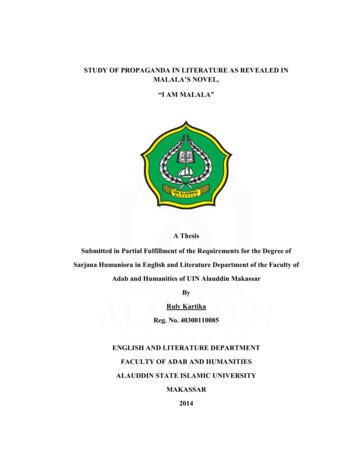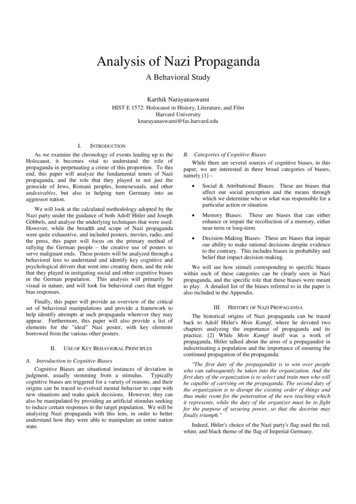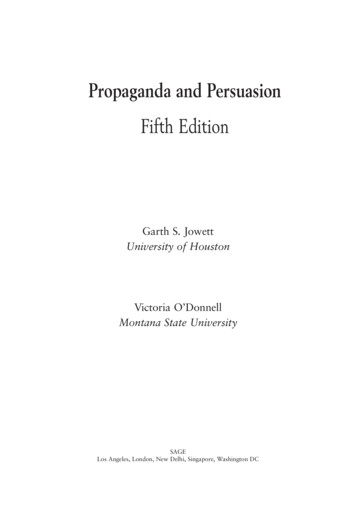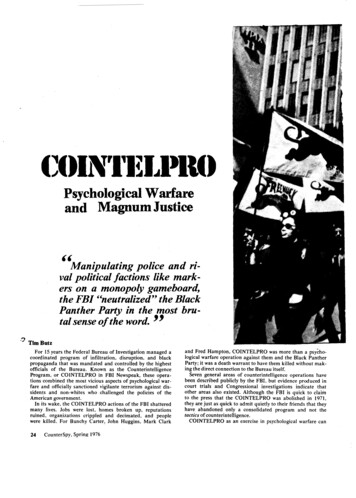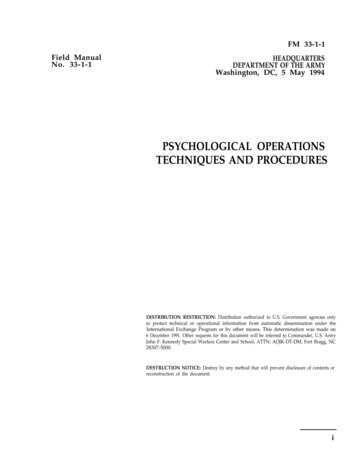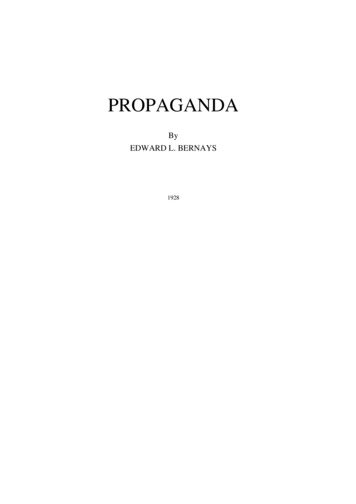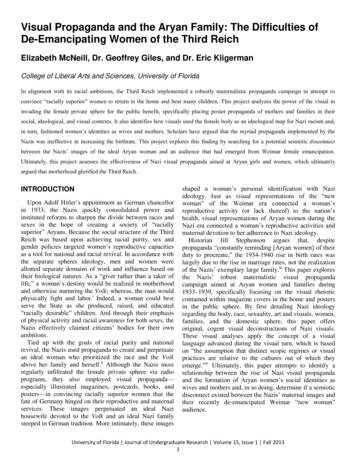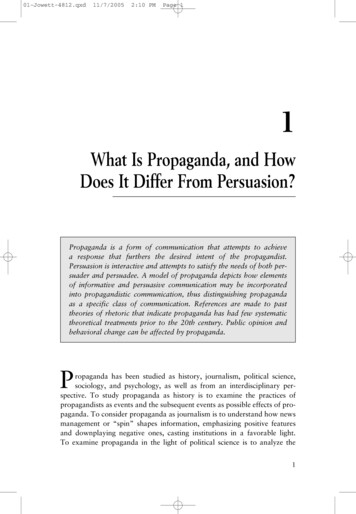
Transcription
01-Jowett-4812.qxd11/7/20052:10 PMPage 11What Is Propaganda, and HowDoes It Differ From Persuasion?Propaganda is a form of communication that attempts to achievea response that furthers the desired intent of the propagandist.Persuasion is interactive and attempts to satisfy the needs of both persuader and persuadee. A model of propaganda depicts how elementsof informative and persuasive communication may be incorporatedinto propagandistic communication, thus distinguishing propagandaas a specific class of communication. References are made to pasttheories of rhetoric that indicate propaganda has had few systematictheoretical treatments prior to the 20th century. Public opinion andbehavioral change can be affected by propaganda.Propaganda has been studied as history, journalism, political science,sociology, and psychology, as well as from an interdisciplinary perspective. To study propaganda as history is to examine the practices ofpropagandists as events and the subsequent events as possible effects of propaganda. To consider propaganda as journalism is to understand how newsmanagement or “spin” shapes information, emphasizing positive featuresand downplaying negative ones, casting institutions in a favorable light.To examine propaganda in the light of political science is to analyze the1
01-Jowett-4812.qxd11/7/20052:10 PMPage 22——Propaganda and Persuasionideologies of the practitioners and the dissemination and impact of publicopinion. To approach propaganda as sociology is to look at social movements and the counterpropaganda that emerges in opposition. To investigatepropaganda as psychology is to determine its effects on individuals. Propaganda is also viewed by some scholars as inherent thought and practice inmass culture. A more recent trend that draws on most of these allied fieldsis the study of propaganda as a purveyor of ideology and, to this end, is largelya study of how dominant ideological meanings are constructed within themass media (Burnett, 1989, pp. 127–137). Ethnographic research is one wayto determine whether the people on the receiving end accept or resist dominant ideological meanings.This book approaches the study of propaganda as a type of communication. Persuasion, another category of communication, is also examined. Theterms propaganda and persuasion have been used interchangeably in the literature on propaganda, as well as in everyday speech. Propaganda employspersuasive strategies, but it differs from persuasion in purpose. A communication approach to the study of propaganda enables us to isolate its communicative variables, to determine the relationship of message to context, toexamine intentionality, to examine the responses and responsibilities of theaudience, and to trace the development of propagandistic communication asa process.We believe there is a need to evaluate propaganda in a contemporarycontext free from value-laden definitions. Our objectives are (a) to providea concise examination of propaganda and persuasion, (b) to examine therole of propaganda as an aspect of communication studies, and (c) to analyze propaganda as part of social, religious, and political systems throughout history and contemporary times.Propaganda DefinedPropaganda, in the most neutral sense, means to disseminate or promoteparticular ideas. In Latin, it means “to propagate” or “to sow.” In 1622,the Vatican established the Sacra Congregatio de Propaganda Fide, meaning the sacred congregation for propagating the faith of the Roman CatholicChurch. Because the propaganda of the Roman Catholic Church had as itsintent spreading the faith to the New World, as well as opposing Protestantism, the word propaganda lost its neutrality, and subsequent usagehas rendered the term pejorative. To identify a message as propaganda is tosuggest something negative and dishonest. Words frequently used as synonyms for propaganda are lies, distortion, deceit, manipulation, mind
01-Jowett-4812.qxd11/7/20052:10 PMPage 3What Is Propaganda?——3control, psychological warfare, brainwashing, and palaver. Resistance tothe word propaganda is illustrated by the following example. When the legendary film director John Ford assumed active duty as a lieutenant commander in the U.S. Navy and chief of the Field Photographic Branch ofthe Office of Strategic Services during World War II, he was asked by hiseditor, Robert Parrish, if his film, The Battle of Midway, was going to be apropaganda film. After a long pause, Ford replied, “Don’t you ever let mehear you use that word again in my presence as long as you’re under mycommand” (Doherty, 1993, pp. 25–26). Ford had filmed the actual battleof Midway, but he also included flashbacks of an American family at homethat implied that an attack on them was an attack on every American. Forddesigned the film to appeal to the American people to strengthen theirresolve and belief in the war effort, but he resisted the idea of making filmsfor political indoctrination. According to our definition, The Battle of Midwaywas a white propaganda film, for it was neither deceitful nor false, thesource was known, but it shaped viewer perceptions and furthered thedesired intent of the filmmaker to vilify the enemy and encourage Americanpatriotism.Terms implying propaganda that have gained popularity today are spinand news management, referring to a coordinated strategy to minimize negative information and present in a favorable light a story that could be damaging to self-interests. Spin is often used with reference to the manipulationof political information; therefore, press secretaries and public relations officers are referred to as “spin doctors” when they attempt to launder the news(Kurtz, 1998). Besides being associated with unethical, harmful, and unfairtactics, propaganda is also commonly defined as “organized persuasion”(DeVito, 1986, p. 239). Persuasion differs from propaganda, as we will seelater in this chapter, but the term is often used as a catch-all for suspiciousrhetoric. Sproule (1994) references propaganda as organized mass persuasion with covert intent and poor or nonexistent reasoning: “Propaganda represents the work of large organizations or groups to win over the public forspecial interests through a massive orchestration of attractive conclusionspackaged to conceal both their persuasive purpose and lack of sound supporting reasons” (p. 8).When the use of propaganda emphasizes purpose, the term is associatedwith control and is regarded as a deliberate attempt to alter or maintain abalance of power that is advantageous to the propagandist. Deliberateattempt is linked with a clear institutional ideology and objective. In fact, thepurpose of propaganda is to send out an ideology to an audience with arelated objective. Whether it is a government agency attempting to instilla massive wave of patriotism in a national audience to support a war effort,
01-Jowett-4812.qxd11/7/20052:10 PMPage 44——Propaganda and Persuasiona terrorist network enlisting followers in a jihad, a military leader trying tofrighten the enemy by exaggerating the strength of its army, a corporationpursuing a credible image to maintain its legitimacy among its clientele, or acompany seeking to malign a rival to deter competition for its product,a careful and predetermined plan of prefabricated symbol manipulation isused to communicate an objective to an audience. The objective that issought endeavors to reinforce or modify the attitudes, or the behavior, orboth of an audience.Many scholars have grappled with a definition of the word propaganda.Jacques Ellul (1965, p. xv) focused on propaganda as technique itself (notably,psychological manipulation) that, in technological societies “has certain identical results,” whether it is used by communists or Nazis or Western democratic organizations. He regarded propaganda as sociological phenomena, notas something made or produced by people of intentions. Ellul contended thatnearly all biased messages in society were propagandistic even when the biaseswere unconscious. He also emphasized the potency and pervasiveness of propaganda. Because propaganda is instantaneous, he contended, it destroys one’ssense of history and disallows critical reflection. Yet, Ellul believed that peopleneed propaganda because we live in mass society. Propaganda, he said, enablesus to participate in important events such as elections, celebrations, and memorials. Ellul said that truth does not separate propaganda from “moral forms”because propaganda uses truth, half-truth, and limited truth. Leonard W.Doob, who defined propaganda in 1948 as “the attempt to affect the personalities and to control the behavior of individuals towards ends consideredunscientific or of doubtful value in a society at a particular time” (p. 390), saidin a 1989 essay that “a clear-cut definition of propaganda is neither possiblenor desirable” (p. 375). Doob rejected a contemporary definition of propaganda because of the complexity of the issues related to behavior in society anddifferences in times and cultures.Both Ellul and Doob have contributed seminal ideas to the study of propaganda, but we find Ellul’s magnitude and Doob’s resistance to definitionstroublesome because we believe that to analyze propaganda, one needs to beable to identify it. A definition sets forth propaganda’s characteristics andaids our recognition of it.Psychologists Anthony Pratkanis and Elliot Aronson (2001) wrote a bookabout propaganda for the purpose of informing Americans about propaganda devices and psychological dynamics so that people will know “howto counteract their effectiveness” (p. xv). They regarded propaganda as theabuse of persuasion and recognized that propaganda is more than cleverdeception. In a series of case studies, they illustrated propaganda tactics suchas withholding vital information, invoking heuristic devices, using meaningless
01-Jowett-4812.qxd11/7/20052:10 PMPage 5What Is Propaganda?——5association, and other strategies of questionable ethics. They defined propagandaas “mass ‘suggestion’ or influence through the manipulation of symbols andthe psychology of the individual” (p. 11), thus emphasizing verbal and nonverbal communication and audience appeals.Other scholars have emphasized the communicative qualities of propaganda. Leo Bogart (1995), in his study of the U.S. Information Agency (USIA),focused on the propagandist as a sender of messages:Propaganda is an art requiring special talent. It is not mechanical, scientificwork. Influencing attitudes requires experience, area knowledge, and instinctive “judgment of what is the best argument for the audience.” No manual canguide the propagandist. He must have “a good mind, genius, sensitivity, andknowledge of how that audience thinks and reacts.” (pp. 195–196)(The quotations enclosed are from the original six-volume classifiedstudy of the USIA done in 1954 that Bogart’s work condenses. The studywas released in abridged form in 1976, and the introduction to it wasrevised in 1995.)Scholars have studied propaganda in specific institutions. Alex Carey(1997) regarded propaganda in the corporate world as “communicationswhere the form and content is selected with the single-minded purpose ofbringing some target audience to adopt attitudes and beliefs chosen in advanceby the sponsors of the communications” (p. 2–1). Noam Chomsky, in hisintroduction to Carey’s collection of essays, said that Carey believed that“the twentieth century has been characterized by three developments of greatpolitical importance: the growth of democracy, the growth of corporatepower, and the growth of corporate propaganda as a means of protectingcorporate power against democracy” (p. ix). Carey said that “commercialadvertising and public relations are the forms of propaganda activity common to a democracy. . . . It is arguable that the success of business propaganda in persuading us, for so long, that we are free from propaganda is oneof the most significant propaganda achievements of the twentieth century”(pp. 1–4, 2–1).Shawn J. Parry-Giles (2002), who studied the propaganda productionof the Truman and Eisenhower Cold War operations, defined propagandaas “conceived of as strategically devised messages that are disseminated tomasses of people by an institution for the purpose of generating actionbenefiting its source” (p. xxvi). She indicated thatTruman and Eisenhower were the first two presidents to introduce and mobilize propaganda as an official peacetime institution. In a ‘war of words,’ propaganda acted as an integral component of the government’s foreign policy
01-Jowett-4812.qxd11/7/20052:10 PMPage 66——Propaganda and Persuasionoperation. To understand propaganda’s influence is to grasp the means bywhich America’s Cold War messages were produced and the overall impactthat such strategizing had on the ideological constructions of the Cold War.(p. xvii)Bertrand Taithe and Tim Thorton (2000) see propaganda as part of ahistorical tradition of pleading and convincing and thereforeas a form of political language, however, propaganda is always articulatedaround of system of truths and expresses a logic of exclusive representation. Itis the purpose of propaganda to convince, to win over and to convert; it hastherefore to be convincing, viable and truthful within its own remit. . . . Theshaping of the term propaganda is also an indication of the way the politicalnation judges the manner in which political messages are communicated. . . .Propaganda promotes the ways of the community as well as defining them.(pp. 2–4)Terence H. Qualter (1962) emphasized the necessity of audience adaptation: “Propaganda, to be effective, must be seen, remembered, understood,and acted upon . . . adapted to particular needs of the situation and theaudience to which it is aimed” (p. xii). Influencing attitudes, anticipatingaudience reaction, adapting to the situation and audience, and being seen,remembered, understood, and acted on are important elements of the communicative process.Pratkanis and Turner (1996) defined the function of propaganda as“attempts to move a recipient to a predetermined point of view by usingsimple images and slogans that truncate thought by playing on prejudicesand emotions” (p. 190). They separated propaganda from persuasion according to the type of deliberation used to design messages. Persuasion, theysaid, is based on “debate, discussion, and careful consideration of options”to discover “better solutions for complex problems,” whereas “propagandaresults in the manipulation of the mob by the elite” (p. 191). Coombs andNimmo (1993) regarded propaganda as “an indispensable form of communication” and “a major form of public discourse;” however, they presentedpropaganda as “the mastery of all modern forms of palaver”—that is, “theuse of guile and charm” (p. 45). Their approach is similar to Ellul’s, for theystate, “The volume and sophistication of the new propaganda is so vast, andgrowing, that we increasingly take it for granted as natural and, thereby, wefind it exceedingly difficult to distinguish what is propaganda from what isnot” (p. 16). Although their major interest is political propaganda, they alsofocus on advertising, marketing, and sales pitches. These definitions vary fromthe general to the specific, sometimes including value judgments, sometimes
01-Jowett-4812.qxd11/7/20052:10 PMPage 7What Is Propaganda?——7folding propaganda into persuasion, but nearly always recognizing propagandaas a form of communication.Jowett and O’Donnell’s Definition of PropagandaWe seek to understand and analyze propaganda by identifying its characteristics and to place it within communication studies to examine the qualitiesof context, sender, intent, message, channel, audience, and response. Furthermore, we want to clarify, as much as possible, the distinction betweenpropaganda and persuasion by examining propaganda as a subcategoryof persuasion, as well as information. Our definition of propaganda focuseson the communication process—most specifically, on the purpose of theprocess: Propaganda is the deliberate, systematic attempt to shape perceptions, manipulate cognitions, and direct behavior to achieve a response thatfurthers the desired intent of the propagandist.Let’s examine the words of the definition to see what is precisely meant.First, deliberate is a strong word meaning “willful, intentional, and premeditated.” It implies a sense of careful consideration of all possibilities. We useit because propaganda is carefully thought out ahead of time to select whatwill be the most effective strategy to promote an ideology and maintain anadvantageous position. Systematic complements deliberate because it means“precise and methodical, carrying out something with organized regularity.”Governments and corporations establish departments or agencies specifically to create systematic propaganda. Although the general public is moreaware of propaganda agencies during wartime, such agencies exist all thetime, for they are essential. For example, as you will see in the case study“Premarin: A Bitter Pill to Swallow,” in Chapter 7, a pharmaceutical company, with the help of a public relations company and a massive advertisingcampaign, waged a campaign to both present its drug as superior and prevent other companies from getting government approval of the genericversion. Advertising campaigns, as you will see in Chapter 3, are forms ofsystematic propaganda. Of particular interest are the advertising strategies of the pharmaceutical industries. Marcia Angell (2004a), author of TheTruth About the Drug Companies: How They Deceive Us and What to DoAbout It, reveals that in the 1990 drug industry annual reports to theSecurities and Exchange Commission and to stockholders, 36% of sales revenues went into marketing and administration. Angell said this category“includes what the industry calls ‘education,’ as well as advertising and promotion” (Angell, 2004b, p. 55). Because of the “rapacious pricing and otherdubious practices of the pharmaceutical industry,” according to Angell, the
01-Jowett-4812.qxd11/7/20052:10 PMPage 88——Propaganda and Persuasionpublic has begun to resist and protest. As a result, she says, the “drugcompanies are now blanketing us with public relations messages. And themagic words, repeated over and over like an incantation, are research, innovation, and American” (Angell, 2004b, p. 52). The pharmaceutical ads thatare prolific on television visually depict healthy people and their familiesenjoying life in the beautiful outdoors while, according to Angell, the verbalmessages say something like this:“Yes, prescription drugs are expensive, but that shows how valuable they are.Besides, our research and development costs are enormous, and we need tocover them somehow. As ‘research-based companies,’ we turn out a steadystream of innovative medicines that lengthen life, enhance its quality, and avertmore expensive medical care. You are the beneficiaries of this ongoing achievement of the American free enterprise system, so be grateful, quit whining, andpay up.” (Angell, 2004b, p. 53)However, as Angell explains, “The prices drug companies charge havelittle relationship to the costs of making the drugs and could be cut dramatically without coming anywhere close to threatening R&D [research anddevelopment]” (p. 54). It is not our intent to target drug companies with thisexample, but Angell’s research reveals that these kinds of propaganda campaigns are both deliberate and systematic.The goal of propaganda is to “attempt,” or try, to create a certain stateor states in a certain audience; thus, propaganda is an attempt at directivecommunication with an objective that has been established a priori. Thedesired state may be perceptual, cognitive, behavioral, or all three. Each oneof these is described with examples as follows:Shaping perceptions is usually attempted through language and images,which is why slogans, posters, symbols, and even architectural structures aredeveloped during wartime. How we perceive is based on “complex psychological, philosophical, and practical habitual thought patterns that we carryover from past experiences” (Hayward, 1997, p. 73). Perception is the process of extracting information from the world outside us, as well as fromwithin ourselves. Each individual has a perceptual field that is unique to thatperson and formed by the influences of values, roles, group norms, and selfimage. Each of these factors colors the ways a person perceives (O’Donnell& Kable, 1982, p. 171). Johnson, in his book In the Palaces of Memory(1991), offered a colorful description of perception and recognition according to the activity of neural networks in the brain:Looking out the window at the ocean, we might notice a bright light in thenight sky hovering on the horizon. Deep inside the brain one neural network
01-Jowett-4812.qxd11/7/20052:10 PMPage 9What Is Propaganda?——9responds to this vector, dismissing it as just another star. But its intensebrightness causes another network to guess that it is Venus. Then the lightstarts getting bigger, brighter, creating a different vector, a different set offiring patterns. Another network associates this configuration with approaching headlights on a freeway. Then two more lights appear, green and red.Networks that interpret these colors feed into other networks; the pattern forstop light weakly responds. All over the brain, networks are talking to networks, entertaining competing hypotheses. Then comes the roar, and suddenlywe know what it is. The noise vector, the growing-white-light vector, thered-and-green vector all converge on the network—or network of networks—that says airplane. (p. 165)Johnson went on to say, “How a perception was ultimately categorizedwould depend on the architecture of the system, that which a person wasborn with and that which was developed through experience. Some people’sbrains would tell them they had seen a UFO or an angel instead of a plane”(p. 165). Because members of a culture share similar values and norms aswell as the same laws and general practices, it is quite possible to have groupperceptions or, at least, very similar perceptions within a cultural group.Our language is based on a vast web of associations that enable us tointerpret, judge, and conceptualize our perceptions. Propagandists understand that our constructed meanings are related to both our past understanding of language and images and the culture and context in which theyappear. Perception is dependent on our attitudes toward issues and our feelings about them. For example, legislation designed to increase timber thinning in national forests has been labeled a “Healthy Forests Initiative.”Environmental groups protested the legislation on the grounds that it wasunhealthy to cut down healthy trees and harm wildlife. Michael Garrity,executive director of the Alliance for the Wild Rockies, revealed that the U.S.Forest Service will make about 312,000 by cutting 4.5 million board feetof timber in southern Montana’s Gallatin National Forest alone (“GallatinNational Forest Thinning Plan Moves Ahead,” 2005). What is “healthy”depends on our associations.“Operation Desert Shield” was changed to “Operation Desert Storm”when U.S. forces invaded Iraq in January 1991. Changing Shield to Stormenabled people to alter their perception of the U.S. military operationfrom “protective” armies to “raging” forces. The second invasion of Iraq inMarch 2003 failed to achieve a successful slogan. “Shock and Awe” wastried, but it only lasted for 1 week. Frank Rich, editorialist for TheNew York Times, said that the television images from the Arab network AlJazeera that depicted American soldiers who had been killed or taken prisoner by Iraqi forces contradicted the slogan. “For the first time we could
01-Jowett-4812.qxd11/7/20052:10 PMPage 1010——Propaganda and Persuasionsmell blood, American blood, and while that was shocking, it was far fromawesome” (Rich, 2003).The war against the Taliban and Al Qaeda had a more successful sloganwith “Operation Enduring Freedom.” President George W. Bush began to usethe phrase “the war on terror” shortly after the attack on the World TradeCenter on September 11, 2001, and continuing through his reelection campaign in 2004. Gilles Kepel, in The War for Muslim Minds (2004), said, “Thephrase was engineered to heighten fear while simultaneously tapping therighteous indignation of citizens in ‘civilized nations’ against barbaric murderers who would perpetrate despicable atrocities on innocent victims” (p. 112).The president, however, made a serious gaffe when, in impromptu remarks,he described America’s goal to annihilate Al Qaeda’s Taliban hosts inAfghanistan as a “crusade.” In the Muslim world, “crusade” representedmedieval European Christianity’s Crusades against Islam. There was an uproarover the religious connotations of the word, which suggested that Bush wantedto conquer Islam. Bush retracted the term immediately and promptly visited amosque in Washington, D.C., in an attempt to nullify the impression thatAmerican mobilization against Al Qaeda was aimed at Muslims or at Islam ingeneral (Kepel, 2004, p. 117). Osama bin Laden, however, was quick to pickup the term and use it in his Al Qaeda propaganda messages denouncingAmerican crusaders. Nevertheless, as Kepel stated, “From both a military anda psychological point of view, the Afghan operation appeared to be a triumphfor the United States” (p. 120). Operation Enduring Freedom did not, however, eradicate Al Qaeda’s effectiveness because it continued its fight via theInternet Web sites, satellite television links, clandestine financial transfers, anda proliferation of activists (Kepel, 2004, p. 121).Perceptions are also shaped by visual symbols. During the second Iraqwar, as in the first, symbolic yellow ribbons have been put on trees, fences,buildings, automobiles, and jewelry to indicate support of the U.S. military.The ritual of tying yellow ribbons can be traced back to the American CivilWar, when women wore yellow ribbons for their loved ones who were awayat war. The 1949 John Wayne film She Wore a Yellow Ribbon reflects thetheme of remembering someone who is away. For television messages aboutprogress in the second Iraqi war, a designer who had worked for Hollywoodfilm and television studios built a 250,000 set for General Tommy Frank’sbriefings in Qatar (Rich, 2003, p. 1). President Bush, wearing combatclothing, visited troops on the aircraft carrier USS Abraham Lincoln onThanksgiving Day 2003 where, beneath a banner that said “MissionAccomplished,” he held up an artificial replica of a roasted turkey.With digital technology, images can go out to television, newspapers,and the Internet instantly. Photographs are easily doctored, making it
01-Jowett-4812.qxd11/7/20052:10 PMPage 11What Is Propaganda?——11difficult to tell what is real and what is not. A video of a man and his12-year-old son, Mohammed al-Dura, cowered behind a concrete structurein the Gaza strip while Israeli soldiers and Palestinian fighters engaged ingun battle, was widely circulated in September 2000. The boy appeared tobe killed and the father wounded in the crossfire. A clip of the boy’s deathwas widely circulated on television worldwide, and stills appeared on thefront pages of newspapers. This visual became a symbol of continuing atrocitiesfor the Palestinian intifada, causing riots to break out in the West Bank andviolent outbreaks against Jews not only in Israel but also elsewhere aroundthe world. According to an article in Reader’s Digest (“Seeing Isn’tBelieving,” 2004, pp. 144–146), there were many indications that the videowas staged.As the dangerous eating disorder anorexia nervosa reaches epidemicproportions among young girls and women, hundreds of pro-anorexia Websites keep appearing on the Internet. These Web sites, which appear to beput up by young anorexic females and friends, offer advice on dieting tipsfor drastic weight loss, strategies to trick parents into believing that theirdaughters are eating, and praise on behalf of extreme thinness. Visual propaganda on these Pro-Ana (anorexia is personified as “My friend Ana”)Web sites features photographs of famous models and movie stars thathave been altered to make them appear even thinner than they actually are.Photographs of extremely obese women are also shown to trigger extremefasting.There is nothing new about propagandists exploiting the media to gettheir visual messages across, for historical propagandists did so as wellin order to shape perceptions. In 1914, Mary Richardson went into theNational Gallery in London and slashed a painting, The Rokeby Venus,a 1650 masterpiece by Diego Velasquéz. At her trial, she said her motivehad been to draw attention to the treatment of the suffragette leaderEmily Pankhurst, who was on a hunger strike in prison. Toby Clark(1997) said,The attack on the painting would have been partly understood as an extension of the suffragettes’ tactic of smashing department store windows, whichassaulted feminized spaces of consumerism like a parodic inversion of shopping. By moving the battle to the nation’s foremost art museum, Richardsonbrought the values of the state’s guardians of culture into the line of fire, andby choosing a famous picture of a nude woman, she targeted the point of intersection between institutional power and the representation of femininity. . . .Richardson had not destroyed the picture, but altered it, making a newimage—the slashed Venus—which was widely reproduced in photographsin the national press, as Richardson had surely anticipated. Though the
01-Jowett-4812.qxd11/7/20052:10 PMPage 1212——Propaganda and Persuasionnewspapers’ response was hostile, demonizing “Slasher Mary” as a monstroushysteric, Richardson had succeeded in using the mass media to disseminate“her” picture of a wounded hero
tion. Persuasion, another category of communication, is also examined. The terms propaganda and persuasion have been used interchangeably in the lit-erature on propaganda, as well as in everyday speech. Propaganda employs persuasive strategies, but it differ
